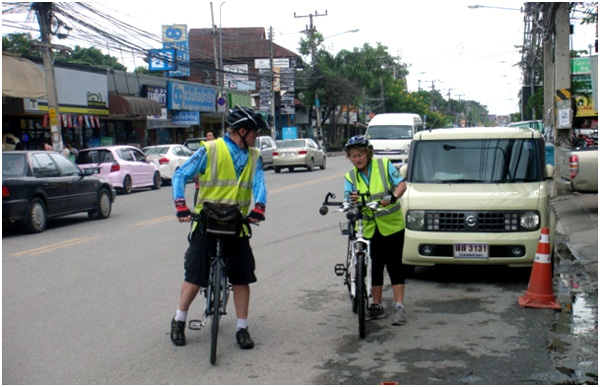Harnessing ‘pedal power’ to promote sustainable urban tourism in Chiang Mai
Harnessing ‘pedal power’ to promote sustainable urban tourism in Chiang Mai
Tourism is vital for the economies of many countries in the South East Asia region, but hotels, restaurants, businesses, travel and all the other aspects of the tourism industry that bring in so much revenue, also carry the downside of generating greenhouse gases and harming the environment.
The challenge: how to foster tourism (create jobs locally and generate revenue) while reducing GHG emissions and preserving the environment?
One answer could be using non-motorised transport such as walking, bicycles and bicycle rickshaws. A research project being undertaken under the CKDN-supported SUMERNET programme looks at how to reduce GHG emissions and at the same time promote sustainable urban tourism in Hue, Viet Nam and Chiang Mai, Thailand. A new policy brief examines the potential for non-motorised transport in Chiang Mai, one of Thailand’s tourism ‘hotspots’.
Estimates of GHG emissions by the tourism sector in Chiang Mai Municipality (CMM) showed transport to be the major source of GHG emissions, equivalent to almost 4,233,300 tons of CO2 in 2011. Travel by just visitors within the city emitted about 3kg of CO2 equivalent per visitor per day – a staggering amount.
[caption id="attachment_23551" align="aligncenter" width="600"] Tourists using bicycles to travel in Chiang Mai (Nimmanhaemin Rd.)[/caption]
Tourists using bicycles to travel in Chiang Mai (Nimmanhaemin Rd.)[/caption]
Development of non-motorised transport (NMT) areas in the city center could offset between 230-570 tons of CO2 per year in Chiang Mai. Though emissions reduction is not very significant through this specific activity, it nevertheless could also bring many other economic and health benefits. Getting rid of cars and replacing them with more sedate forms of transport such as walking or cycling, would give tourists more time to look around and to purchase handicrafts and other goods from local vendors – thus helping the local economy. The same effect would result from the increased demand for rickshaws and bicycles. And, of course, noise and dust pollution would be significantly reduced.
Setting up NMT areas within cities, and generally encouraging people to walk, cycle or use public transport, are policies that many countries are already pursuing – some for many years now. Scandinavian countries, notably Denmark, as well as the Netherlands, are famous for using ‘pedal power’ to get around. The Dutch NMT policy dates back to the 1990s: the number of inhabitants per bicycle in the Netherlands is 1.0. Japan, Australia, South Africa and Indonesia are just some of the many countries to have initiated NMT schemes. These have had a marked impact on cutting GHG emissions from transport: pedestrianisation of Malioboro Road in Yogyakarta, Indonesia, in 2005, for example, cut traffic in the area by 30%.
In order to establish NMT areas within Chiang Mai Municipality, it will be important to carry out a detailed traffic assessment and modelling exercise to identify appropriate scheme boundaries, traffic displacement issues and so on. It will also be important for CMM to incorporate NMT components in its transport master plan, and to invest in NMT infrastructure, such as construction of segregated lanes and parking for non-motorised vehicles.
The SUMERNET project on sustainable urban tourism in Chiang Mai and Hue is being conducted by researchers from the Asian Institute of Technology (AIT), Chiang Mai Municipality, Hue People’s Committee and Hue University of Sciences. It entails use of a carbon accounting tool ((Bilan Carbone® developed by French Environment and Energy Management Agency (ADEME)) to estimate the GHG emissions of the urban tourism sector in these cities. The aim is to use the findings to identify options for low carbon emissions and poverty alleviation. These will in turn foster the development of action plans and policies on climate compatible urban tourism development.
For more details on the project see the Sumernet website: www.sumernet.org. or the project website: www.sut.ait.ac.th
This policy brief on NMT can be downloaded from here.
